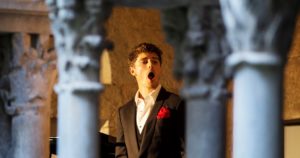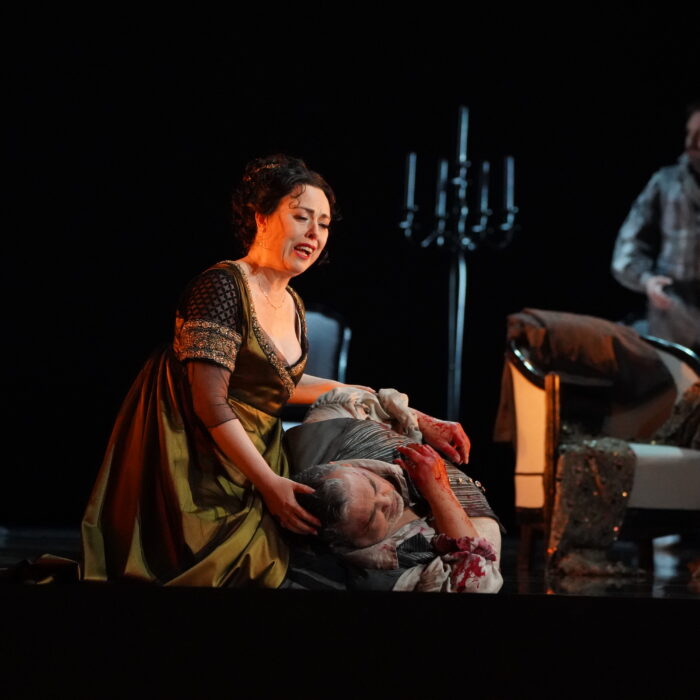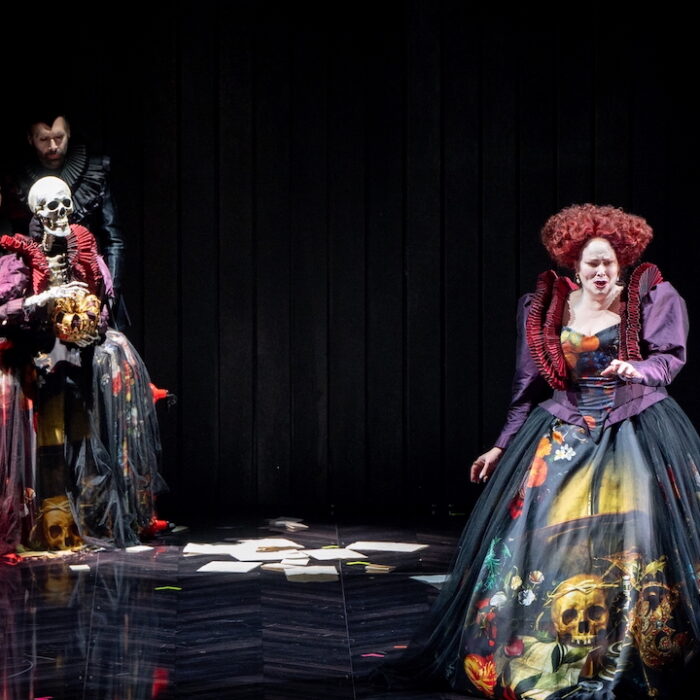
Festival Nits de Clàssica Girona 2018 – Jakub Józef Orliński
Prodigious Polish Countertenor Survives Shadow of ‘Game of Thrones’ & Delivers A Nit Estupenda in Girona
By Jonathan SutherlandMany Music Festivals rely on remarkable locations to give performances their particular “festive” appeal. The awe-inspiring Arena di Verona, the ancient Aya Irini church in Istanbul, the umbrageous plane trees in Aix-en-Provence, the picnic-enticing gardens of Glyndebourne, the striking castle-fortress of Savonlinna, or the entire picture-postcard-perfect city of Salzburg immediately spring to mind.
The medieval town of Girona in Catalonia is no less picturesque and gives its own special magic to the Festival Nits de Clàssica, which is now celebrating its seventh year. The Catedral de Santa Maria de Girona is probably more familiar to non-music buffs as the site of the Sept of Bael in “Game of Thrones” Part VI but the stupendous 12th century Catalan Romanesque Claustre de Sant Pere de Galligants, just a few long-bow lengths away, has been hosting musical events long before Arya Stark disposed of the Waif. Admittedly “Game of Thrones” is known to a global audience, but for the 150 lucky music lovers at this sold-out cloisters concert, the cantilena of the immensely talented young Polish countertenor Jakub Józef Orliński was infinitely preferable to caterwauling Stone Crows or wailing Wildlings. At only 27, Orliński is already considered one of the world’s leading exponents of Baroque and Early Music. He also has the novel talent of being an award-winning break-dancer, making the accomplished Varsovian a fusion of Farinelli and Phisicx.
Overcoming the Heat
The Girona setting is unique in many ways. Apart from the obviously exceptional architectural aesthetics, the performing space of the Claustre is a corner intersect of two cloisters, meaning the audience sits in two distinct branches at right-angles to the small stage. The unusual configuration was cleverly utilized by the dramatically demonstrative young singer who frequently turned to reinforce dramatic emphases in the text. The only negative was that the mid-summer heat and humidity in the low-ceilinged cloisters was overwhelming. Spanish devotion to ventiladores de mano made a lot of sense. Even a promotional flyer for the Festival was cut in the shape of a fan to enhance personal ventilation. There were so many fan-flapping wrists it was as if the audience had crashed the last act of “Carmen”.
Orliński made some small changes to the printed order of the program and opened with “Stille amare già vi sento” from Handel’s Ptolemaic fantasy “Tolomeo re d’Egitto”. This gave his fellow Juilliard alumnus, pianist Sophia Muniz, the chance to pound out some emphatic B flat quavers to introduce the “inumano fratel” recitative. A beautifully controlled A flat crescendo fermata on “mandi un sospiro” was an early indication of the superbly nuanced singing to come. The larghetto was memorable for Orliński’s outstanding word colouring and some Marilyn Horne-ish chest notes such as the low B flats on “a chiamar”. Tasteful ornamentation in the da capo, excellent breath control and an exciting extended fermata on the final “tutte in seno” made this encomium to suicide by poison particularly persuasive.
According to Eveline Cruickshanks’ “History of Parliament: the House of Commons 1690-1715,” Colonel Henry Heveningham was “a fop and pretended wit.” This didn’t prevent him from writing the text for Purcell’s song based on the opening lines of Shakespeare’s “Twelfth Night,” “If Music be the Food of Love.” Orliński immediately let loose with some dazzling embellishments on “sing,” “joy,” and “move,” which could not have failed to impress the lady with the musical eyes, mien and somewhat suggestively, tongue.
More Purcell
There was more Purcell with “What Power art Thou” from his 1691 five-act opera “King Arthur” which pre-dated the Broadway musical “Camelot” by about 300 years. Purcell scholar Peter Holman considers its daring chromatics a high-point of the English master’s original compositional style. For obvious textual reasons the aria is also known as “The Cold Song” with disconcerting lines such as “let me freeze again to death,” which was actually a very appealing proposal in the 43 degree hornos Catalán heat. Munoz again kept the strict 4/4 quaver rhythms metronomically precise with a powerful climax before Orliński lept into the Génie du Froid’s Winterreise-ish supplication with delineated diction and expertly measured chromatic crescendi reaching a formidable head voice fortissimo.
Purcell was Court Composer to Queen Mary II (of the famous “William and Mary” double-act) and in 1694 wrote a birthday Ode in her honour called “Come ye Sons of Art” which wasn’t such a good-omened offering as the demure monarch died shortly after. One of the highlights was an invocation to the musical instruments of the Muses, “Strike the viol, touch the Lute” which is also part of the “Orpheus Britticanus” folio. The original orchestration included recorders, strings and basso continuo which not only provide the chirpy accompaniment but indeed the very subject of the aria. Despite highly proficient playing, Munoz was obviously unable to replicate these sonorities on the piano and the ritornello was sensibly omitted. Orliński’s roulades were impressive, although there were occasional upper register quirks in intonation. That said, the youthful countertenor’s phrasing was exemplary and “Touch, touch” and “Sing, sing” had a seductive sensuality.
Handel
Back into more familiar territory with Handel’s “Rinaldo,” Orliński brought surprising insight into Eustazio’s “Siam prissimi al porto” even without the usual diversion of seductive Sirens splashing around in the spume. The quaver rests were scrupulously observed, chest notes rich and resonant and the da capo ornamentations such as “per prender conforto” thoroughly Handelian in execution.
Dripping in perspiration but still immaculate and engagingly cheerful, Orliński closed the first part of the programme with Arsace’s show-stopper aria “Furibondo spira il vento” from “Partenope.” As Handel’s first frivolous operatic work, it made a welcome contrast to the Sturm und Drang of the earlier selections. There were plenty of fireworks in the 6/8 allegro semiquavers, even if the aria is long on leaps and roulades and short on substance. The original Arsace was sung by the corpulent castrato Antonio Maria Bernacchi, who was once described as “as big as a Spanish friar.” By contrast, the handsome young Polish countertenor was visually much more credible as one of Partenope’s persistent suitors. There was no shortage of dazzling vocal pyrotechnics, but a sustained E natural at the top of the stave was not as intonation-secure as several low chest voice B naturals. Orliński’s embellishments at the short concluding two bar adagio section before the da capo were particularly well-nuanced with some crystalline trills on “dal mio duol.” Sophia Muniz’s nimble fingers scampered over the keys with panache and aplomb.
Post-Intermission
After a short interval Orliński returned to the maudlin mood with “Lucisssima face” from Francesco Cavalli’s “La Calisto” but there was a contrasting impressionistic serenity in the five songs by Reynaldo Hahn (1874-1947) which followed. “A Chloris” is marked “tendrement” and “piano”. Orliński was certainly tender in timbre but the piano wasn’t quite as hushed as specified. A sustained diminuendo B natural on “au mien” however was beautifully coloured. The word “que” seemed to present recurring diction problems. Dedicated to Massenet, the directions of “Paysage” are “un peu lent” “pianissimo” and “très intime,” but on this occasion Orliński was slightly rushed and a bit too public. That said, there was fabulous breath control on diminuendo semibreves such as “bourdonner.” The key change to E major brought some delicious light word painting on “Des chênes faisant” and later “sirène.” A rapturous concluding crescendo “De sa basse infinite” helped to made this chanson the highlight of the Hahn selections. The sparkling “Fêtes Galantes” is marked “avec élégance” and Sophia Munoz excelled in the pixie-ish accompaniment. Orliński played the coquette in the octave leaps but articulation of the rapid-fire text was variable and the top G on “parmi” neither pianissimo nor pristine. In the Schirmer edition, “L’Heure exquise” is translated as “The Hour of Dreaming” and scored “tranquillo e dolce possible”. Monuz brought a nocturne-ish mysticism worthy of Cortot to the gentle 6/8 accompaniment which Orliński mirrored in his finest soft singing of the evening. The sustained piano phrase “O bien aimée” reaching a delicious D natural was masterful.
Another bravura aria by Handel finished the official programme, this time “Agitato da fiera tempeste” from “Riccardo prima, re d’Inghilterra.” Orliński tossed off the rapid semiquaver roulades with accuracy and assurance and the low B flats were wonderfully round and fruity. Munoz kept the grande vitesse of the tricky accompaniment safely on track.
Ever since a YouTube clip of Orliński singing Vivaldi’s “Vedrò, con mio diletto” in thigh-bulging shorts and an open sports shirt in Aix-en-Proence become an overnight internet sensation, this aria from “Il Giustino” has become as synonymous with the charismatic young Pole as “Home, sweet Home” was to Dame Nellie Melba. Certainly the Vivaldi is infinitely more difficult to sing than Henry Bishop’s schmaltzy jingle. Orliński has a natural affinity for this repertoire and was more adept in its delivery than in the chansons by Hahn. His trademark breath control was superabundant and the creamy caramel low D natural chest notes were sepulchral. The da capo brought an amaranthine high F sharp fortissimo fermata on “vedrò” which seemed to shake the very foundations of the ancient cloisters. Subtle ornamentations with plenty of mini cadenzas followed.
A repeat of “Strike the viol, touch the Lute” was more assured than the first time round and Munoz’s cheeky musical joke of inserting a tierce de Picardie at the end exemplified the relaxed nature of the concert.
Jakub Józef Orliński is unquestionably a very fine singer with innate musicality, dramatic insight and a highly attractive stage presence, with or without the break-dancing. This is a career destined to soar into the operatic stratosphere faster than a demisemiquaver Rossini roulade.


